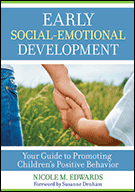How Proactive Approaches Help Resolve Challenging Behavior
Published Challenging behavior is a critical issue in any early childhood learning environment. Excerpted and adapted from Nicole Edwards’ book, Early Social-Emotional Development, the story featured in this blog post shows how early educators can improve lives—for young children and whole families—by taking a positive, proactive approach to challenging behaviors.
Challenging behavior is a critical issue in any early childhood learning environment. Excerpted and adapted from Nicole Edwards’ book, Early Social-Emotional Development, the story featured in this blog post shows how early educators can improve lives—for young children and whole families—by taking a positive, proactive approach to challenging behaviors.
Meeting Matthew
Ms. Terri is the lead teacher in a center-based class for toddlers with diagnosed delays and disabilities. Halfway through the school year, the center director notifies her that a new child, Matthew, has qualified for early intervention services due to a sensory and speech-language delay and has been enrolled in her class. The next morning, Matthew and his mother enter the classroom for the first time. As other toddlers arrive and begin playing, Matthew remains quiet, clinging to his mother’s leg. Ms. Terri warmly greets Matthew and his mother. She puts various toys and puzzles on the table for Matthew to explore.
After a few minutes, Matthew’s mother says she is late for work and is fearful she will lose her job because of everything that has been happening with Matthew. “Yours is the third preschool program he has been in this year,” she explains. “If you tell me he can’t stay, I don’t have any other options.” Ms. Terri learns that due to Matthew’s externalizing behavior (noncompliance with teacher requests, pushing staff and peers), he was asked to leave two other child care programs. Ms. Terri is aware of the high expulsion rate in early childhood settings, but this is the first time she has met a family directly affected by this.
Over the remaining months, Ms. Terri and the assistant teacher, Ms. Diana, work to create an environment that will help Matthew—and all his peers—succeed. Here’s what they provide:
Clear expectations and visual cues
Ms. Terri and Ms. Diana develop a supportive, trusting rapport with Matthew. This rapport develops within the positive, orderly, and safe classroom environment they have established. They set clear, appropriate expectations for all students before they enter the room in the morning (e.g., getting to eye level and having students touch picture cues or repeat the statements, “First we hang up our coats, and then we sit on the carpet”). They also do so throughout daily classroom activities, especially during transitions.
For example, before Matthew transitions to working one-on-one with his speech-language pathologist, Ms. Bonnie, Ms. Terri hands him two rectangular pieces of cardboard, with Velcro attaching a fork to one and a yellow ribbon to the other. She says, “Matthew, in 2 minutes we’re going to put away our puzzles. Do you know what comes next? Look, Matthew.” She prompts him to touch the fork. “First, we’re going to have lunch.” She guides him to touch the yellow ribbon as she explains, “Then, Ms. Bonnie will work with you in her room for a little bit.” After lunch, when Ms. Bonnie arrives, Matthew is guided to peel the yellow ribbon from the cardboard to hand to her. When they walk together down the hall, Matthew notices that Ms. Bonnie has the same yellow ribbon on the outside of her door. This process requires some advance planning and commitment to a predictable schedule, but it helps Matthew and his peers understand what is happening next and transition smoothly between activities.
Social-emotional coaching
Ms. Terri and Ms. Diana also validate, reinforce, and redirect emotional displays when needed, provide Matthew and his classmates with meaningful opportunities to make choices, and model emotion coaching and responsiveness when they are distressed. They use a feeling chart, posted on the back of the classroom door, and picture cues as needed.
For instance, one day another student leaves school early with her father. Immediately afterward, Matthew covers his eyes and starts to cry. Ms. Diana gently guides him to the feeling chart and says, “Can you point to the picture that shows how you’re feeling right now?” Matthew points to the crying face. “It looks like you’re feeling sad,” says Ms. Diana, encouraging Matthew to echo, “I feel sad.” He nods when she asks if he misses his mommy. She validates that it’s okay to feel that way and assures him he will see his mom later that afternoon. The teachers praise Matthew for letting them know how he feels, redirect his attention by asking him to choose between two of his highly preferred activities, and stay nearby to give extra attention as needed.
Careful observation and collaboration
Ms. Terri and the other service providers take detailed notes on what progress Matthew is making in working toward desired outcomes. They also arrange time to call and/or meet with Matthew’s mother, the speech-language pathologist, and the occupational therapist to brainstorm ideas, share progress updates, and encourage continuity in strategy use across people and settings.
Within a few months, the team has become keen observers of Matthew’s strengths and emerging skills and praise him for his progress. He now:
- increasingly uses adaptive wording to communicate thoughts and feelings (e.g., “I feel sad”; “Help please”)
- follows more one- to three-step directions with minimal verbal or gestural prompting
- transitions more calmly between activities
- is more willing to share with peers, take turns, and participate in small-group activities
At the end of the year, when it’s time to assess eligibility for preschool special education, Matthew’s mother is amazed that he does not qualify for services. “I can’t believe it,” she tells them. “You have given me a new child!”
Ms. Terri and Ms. Diana embedded many developmentally appropriate components in their teaching practices, such as setting clear expectations and incorporating multiple modalities so children not only hear instruction, but also see visual cues and touch tactile cues to enhance understanding. Ms. Terri also highly values team collaboration and facilitates ongoing meetings for service providers and Matthew’s caregiver to share ideas and updates. Ms. Terri and Ms. Diana are laying a strong foundation for positive behavior in their classroom, and they helped make a difference for both Matthew and his mother.
Addressing behavior issues early is key—as Nicole Edwards notes, “challenging behaviors that persist into the preschool years are likely to continue through adulthood in the absence of intervention.” Use Matthew’s story as inspiration for proactively addressing challenging behavior in your own early childhood program.



